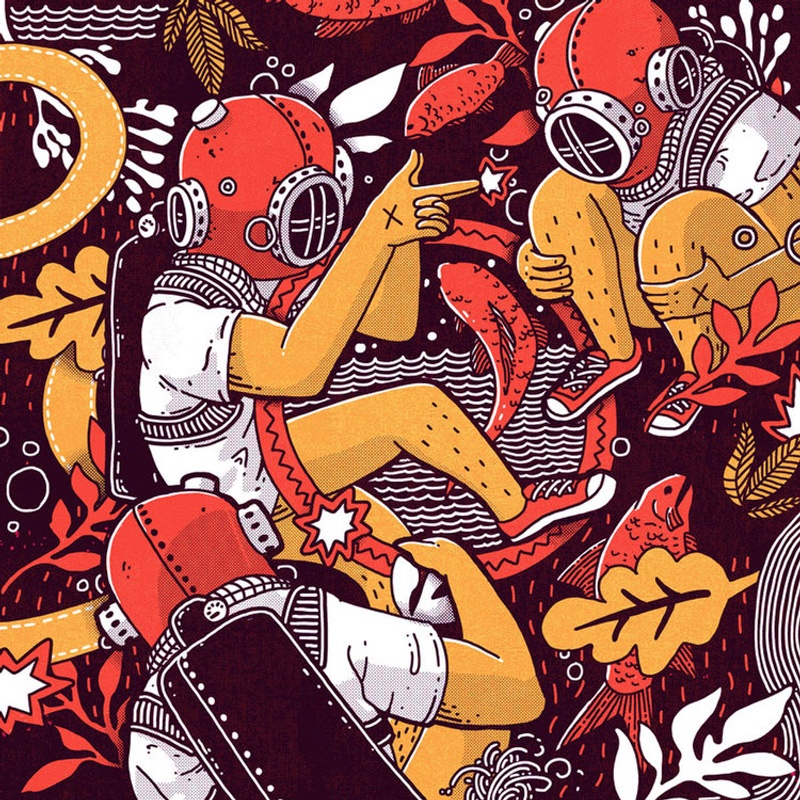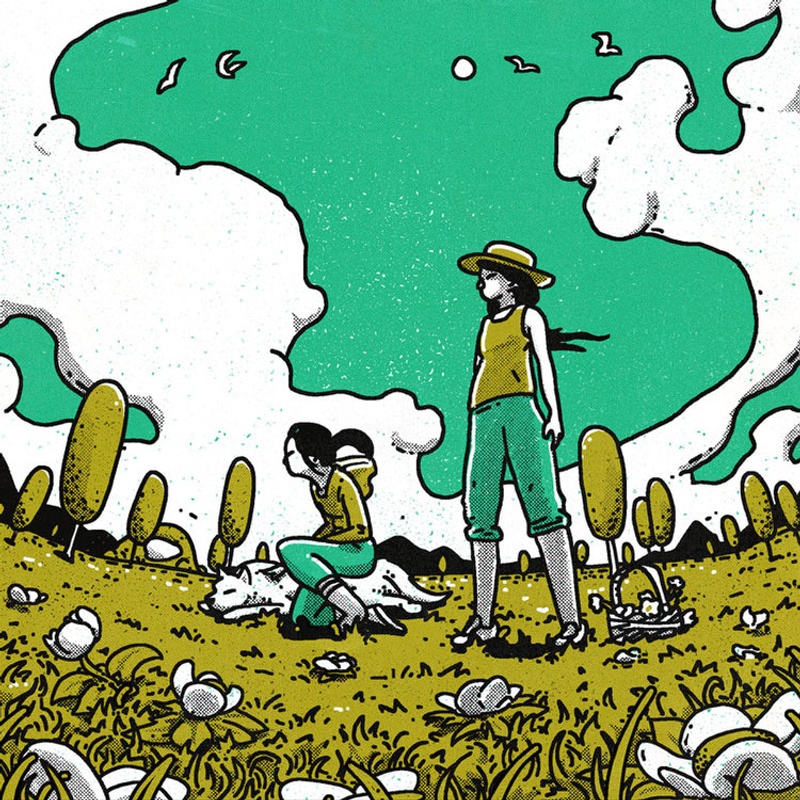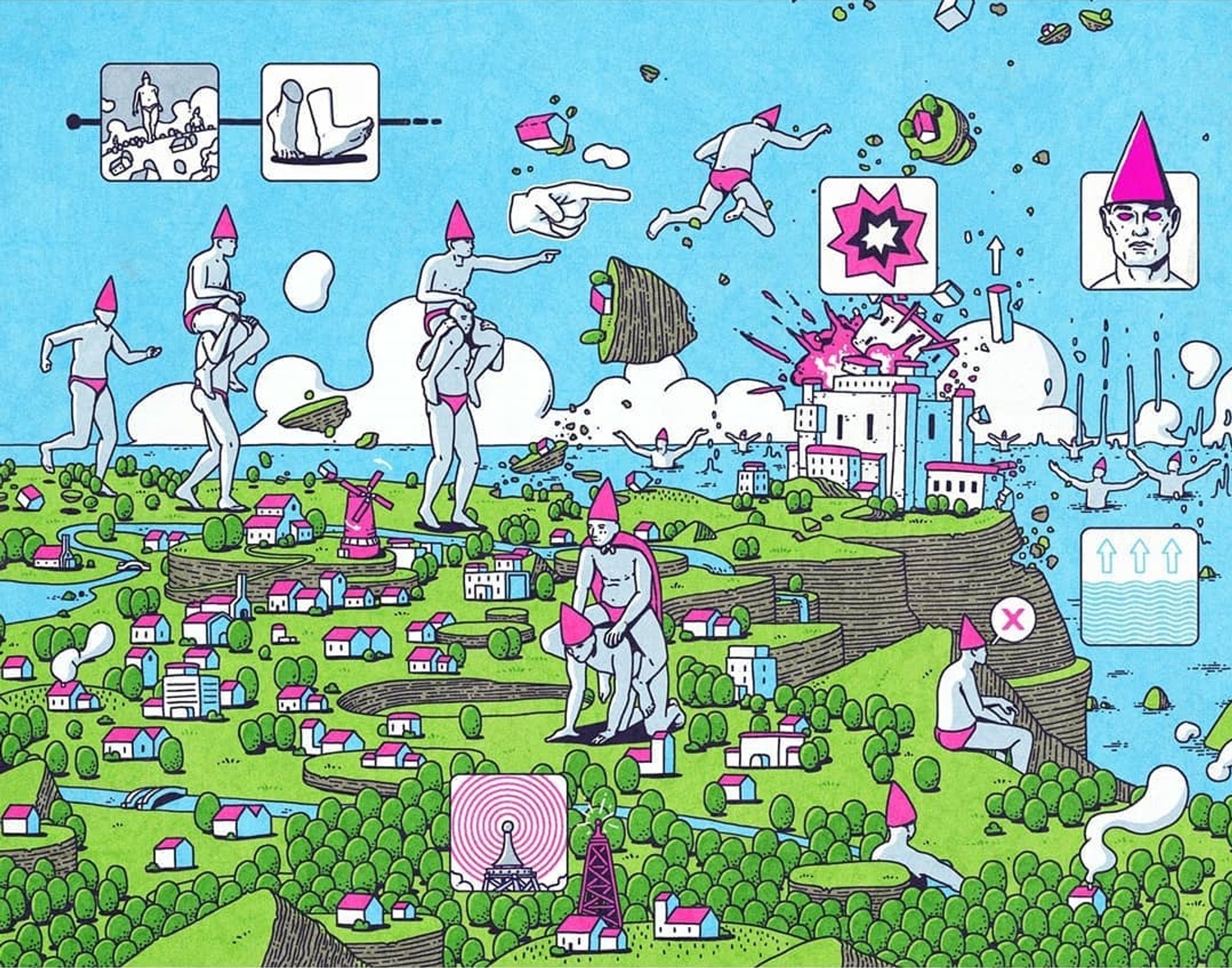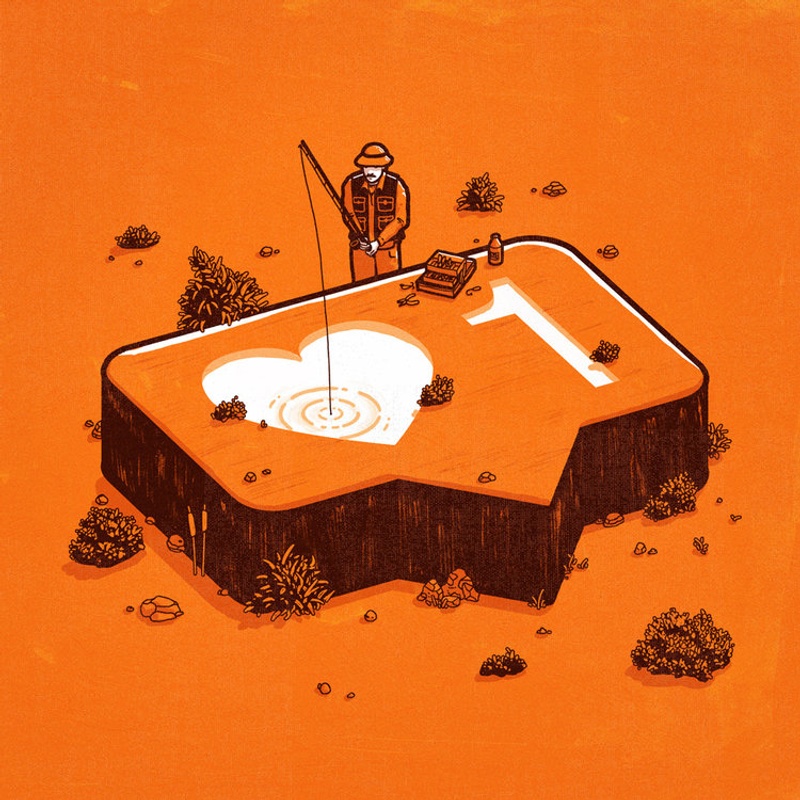On learning how to be a creative entrepreneur
Prelude
Ronan Lynam works as an illustrator providing his vivid and colorful style of illustration for a wide variety of promotional, editorial, and retail projects. He is currently based in Washington, D.C.
Conversation
On learning how to be a creative entrepreneur
Illustrator Ronan Lynam on growing into your own signature style, how to survive in the real world after finishing art school, working around creative blocks, and tending to the business side of being a professional creator.
As told to Ambrose Mary Gallagher, 3169 words.
Tags: Art, Design, Process, Beginnings, Money, Promotion, Adversity.
I love the voice that you have in your art, your distinctive style. What went into the development of that?
Going way back, in high school, I was doing all the advanced art classes, doing a lot of that stuff. It was around that time that I started seeing these videos online of people drawing digitally, and I had never really seen anything like that before. It just blew my mind. I really, really wanted to try it. So before I went to art school, I picked up a digital drawing tablet, and from that I started to learn how to draw digitally.
For the first long while when I was doing that, I was doing more of a fluid digital painting type of style, where it’s kind of emulating traditional techniques. I was doing that, and then, as a tangent to that, I started doing more of a graphic, simple style, because I had found t-shirts, and submitting to these t-shirt competitions was a good outlet for me to make a few bucks while in college.

So, from there my style of illustration had a split, where it had the more digital painting stuff on one hand, and then the more graphic stuff on the other. There was a long time where I was struggling to develop those both at the same time. It wasn’t until after I graduated and I was out in the world that I started to realize I need to focus on something. I think a big problem is if you have a portfolio site where you have work that almost looks like the work of two different people. It’s not cohesive. It’s really important to have your own thing that you just completely own. I started thinking, “What do I want to be doing?”
There was a period where I was trying to combine the two—the digital painting stuff and the graphic stuff—to try and see if I could mix them together and experiment with that. Coming out of that, I guess you could say the more graphic stuff won: simple line work, limited color schemes, things like that. I don’t know, it just really gets my rocks off. [laughs]
Do you find it constricting at all to have a style like that to stick to?
I wouldn’t be doing it if I found it constricting. The reason I feel like it took so long to land on something was because I didn’t want to force anything. If you’re forcing it, you’re just going to be miserable, you’re not going to enjoy what you’re doing. So, it took a long time until I got to something where I was comfortable, where I could work like this all day and I wouldn’t get bored of it. This just feels right.
It seems like you’re doing a lot of different types of freelance design work. You’ve got t-shirts, you design magazine covers, and a lot of other stuff. How do you find, or make, opportunities like that?
Basically, I would describe my income as coming from two different places. One is t-shirts and prints and stuff, and I’ve gotten to the point where that’s almost completely passive… That sort of provided a base income for me to start to hunt down different types of opportunities. So, you’ve got the passive stuff, and then you have the not-so-passive stuff, which is something that I personally really, really struggled with for about two or two and a half years after graduating from art school. One of the common criticisms with art school is they don’t really teach you how to survive once they kick you out the door.

I mean, you’re sitting around, you don’t really know how to make a living, and you think oh, maybe if I throw some stuff online and develop a little bit of a following, that will start to help, and opportunities might start trickling in. And that’s true, that does happen, but it’s not nearly enough to sustain yourself. At that point you have to realize, either you can take a passive approach to self promotion, or you can just go forward with a more proactive approach. Meaning that you take it into your own hands, that you reach out to people. You try and hunt down as many opportunities that you can.
The common way to do that is by cold calling or cold emailing. I mean, that’s the purpose of a portfolio site. You put your portfolio site together, and then you show it to people who you think could use what you have. So with the magazine stuff, like newspapers, I would reach out to the art directors and say, “Hi, I’m an illustrator, I would like to work with you, blah blah blah. Here’s my portfolio.” That in itself is really, really tough because there’s just an overwhelming amount of rejection and, even more frustrating than that, just no reply.
It’s like, “Please reject me, at least.”
Yeah, exactly. Please reject me. It’s understandable that a lot of these people must get tons and tons of illustration promotions from people, I never expect to hear back, but even just a no means they saw your portfolio and they’re like, “Maybe, but not at this time.”
During that two and a half years that you went through after art school, how did you keep going, just economically?
Right off the bat, I was making a little bit with the t-shirts and prints and stuff. Just understanding my own situation, first of all, I moved into a place with my girlfriend. Right there, my cost of living was cut in half. I’m very, very, very fortunate to have my art school paid for. I didn’t have student loan debt. So, overall I tried to keep my cost of living as low as I possibly could. Thankfully, I was able to sustain myself with the very little money that I was making. For a lot of people, they just can’t do that. They have to get a day job, and try and work it out on off hours, you know? So, I feel thankful that I was able to just kind of jump into it, even if it was really, really, really slow at first.
So, find a girlfriend, that’s a top tip.
Find somebody special, and split all your costs with them fifty-fifty.

So, as you’re juggling these different freelance things and reaching out to get other stuff, what keeps you motivated to keep making your own work?
My own personal work? That’s the fun part. When you don’t have any other immediate projects going on that you have to do, nothing with a due date, I just like to keep making stuff. As time goes on, it’s always in the back of your mind, like, “What am I going to do with this piece?” I guess one of the things I’ve been trying to work on recently, is just to empty my head of that stuff and remember, you don’t have to share this. You don’t have to put it on your portfolio site. It doesn’t have to be something, you can just do it for fun and enjoyment like it used to be.
Are you saying that you find intrinsic joy in your art?
[laughs] Yeah, it might be. Sometimes you get real frustrated. Art block is a real thing.
What’s your experience with art block, when does that come up?
Sometimes I feel like I go through periods of productivity, where I feel very motivated and inspired and I’m able to pump out a few things. I get really focused, and when it’s done I feel like I’ve got nothing left. I don’t know what to do next. And I feel like I was trying to force things, and trying to push things further and… I don’t know, I’ve been dealing with that for a long time now, and I feel like I have a few methods of getting over that. One of the biggest methods, one of the little tricks I use, is basically when you get frustrated with what you’re doing, is just to take a step back and not overthink things too much.
I think anyone who does anything creative sort of has a safe zone, a comfort level where they can just do whatever they want, and they just feel really good about it. Draw the things that you know are really easy for you, because that will set you back on a path of being productive again, and keep you motivated, because it kind of gives you the push. Doing something really easy to continue on to doing something harder later on. Does that make sense?
Kind of like putting “take a shower” on my to-do list.
Exactly. Like giving yourself an easy chore, or an easy job to do in order to move on for the harder task of pushing forward.
Where do you get your ideas from?
I would say there are two ways I think of stuff to draw. One of the ways is that I have a preconceived idea, and that can come from anywhere… I have a list on my computer of these random topics I could draw around. The other way is to generate it as you go. I don’t know if this will make sense, but sort of like designing stuff around the composition, rather than the idea. Like, “Oh, here’s something. I could add something to this corner, add a focal point over there, balance it out a little over here with something else, and add a different color over here.” To kind of work more like that, spontaneously.
So you’re looking at it aesthetically, rather than…
Yeah, more aesthetically and decoratively, rather than a conceptual idea that I’m trying to execute.
We already touched on social media stuff, but I always ask everybody this because it’s a huge problem in my life: How do you balance the necessary promotion and benefits of social media stuff with the time wasting and FOMO sides of it?
Well, the FOMO—the fear of missing out, right?—in some ways that’s almost the worst thing about social media for me. Again, I follow many, many, many different illustrators and artists, so that I have a feed of inspiration. But at the same time, on social media you can see all these people, and they’re working on opportunities way outside your league, and they’re being super successful, and doing all these cool things, and you’re sitting in your apartment in your underwear on Reddit, drinking a cold bagel.
You’re drinking a cold bagel?
[laughs] Drinking a cold coffee and eating a bagel. But that’s something, I don’t know… It’s like that with getting the “likes” and everything. If you post something, and it doesn’t get a lot of likes, does that mean you made a bad piece of work that’s not interesting? It isn’t true at all, but you get obsessed with the numbers. “Oh man, I used to get so many more likes back in the day. What am I doing wrong?”

Thankfully I’ve kind of just stopped caring, in a way. But I guess the FOMO is kind of the big bummer. You just see all these other people doing all these cool things, and you don’t feel like you’re there yet, and you’re like, “Oh man, what if this is it for me. Things are never going to get any better, and I’m not going to reach these levels that these other people have gotten?”
I think that is the poison of social media. You start to get jealous of other people’s lives, and start to feel bad about your own. You feel like you’re wasting time. I try and keep off it. I try and not feel that way about Instagram, but it’s sometimes easy to fall into that pit. I’m sure I’m not the only one.
Definitely not. I think ideally it would be motivating, but a lot of times it just feels like, “Oh, I don’t really see a pathway from here to there, so…“
Yeah—what do they do differently, that I’m not doing?
What do you see on the horizon for where you would like to be?
I feel like I’ve been on a pretty good path. I think I just need to keep practicing my stuff, creating new, better work. Probably my biggest struggle is the consistency of keeping up with my own self promotion, because I touched on how defeating it can be, and how it just sucks. You try, and you try, and you try, and you just, more often than not, do not see the fruits of your labor. But it’s important to keep at it. I’m at a place now that I didn’t think I would be several years ago, and I’m sure in many years I’ll be at an even better place, working on bigger and better projects.
Do you have any resources that you use to get through that promotion part of it?
Yeah, so I use a Google spreadsheet. Being an artist and an illustrator, like any sort of independently creative worker, it’s a lot more entrepreneurial than I ever anticipated, and it really helps to strip it back and to start to think of yourself as a one-person business. That takes out all the sexy mysteriousness of being an artist and everything, but taking a step back and reframing your work in that regard, I think, can help set you on a better path.
That’s what it did for me, thinking: “I’m a person, and I offer goods or a service, my illustrations, so I need to find people who can use what I’ve got.” For example, the Detroit Metro Times, I saw that they use illustrations for their cover sometimes… I went on their website, got the email of their art director, and I put that in the spreadsheet. I reached out to them, and I logged when I did that, and if I got a response. They said, “Hey, we love your work and I’ll keep you in mind for a future project,” which is a great response, that’s what I want to hear…
Even just reaching out to somebody shows them, “Oh, this is somebody who has their own initiative.” It’s already a point in your favor, even though a lot of them just never respond.
I think people can be really, really surprised by how far a simple, friendly introductory email can get you. Just state your intent, who you are, why you want to work with them, and a link to your stuff. That’s it.
Just frame your work!
Yeah, and then if it’s a good match then, that’s great. And if it’s not a good match, it doesn’t necessarily mean your work is bad or anything. It just might have not been right for that particular opportunity. There might be a better home for it somewhere else.
That makes a lot of sense. To go back to the process: how do you decide that a piece is done? How do you stop tinkering with it, and be like, “I’m putting this out there”?
That’s actually one of the reasons I moved away from the more digital painting stuff… I never could really decide if something was done. With painting techniques, you blend things, and you render things out, and it’s like, “How much do I render something out before just leaving it? How loose can I keep something before walking away from it?” That’s kind of the reason why I moved over to the more graphic stuff, because you draw a line, you fill it in, and you add some color… Then you can walk away and move on to something else.
If you get stuck and you don’t really know how to proceed you don’t have to sit there and knock your head against the screen, or the table. Move on to something else, come back with a fresh perspective, and you will have the answer to your question.
What’s something that you wish somebody had told you when you began to make art?
Understand how entrepreneurial this is all going to be. As an artist, you don’t have to make a living with your art if you don’t want to. There’s nothing wrong with just doing it for your own enjoyment, or to express yourself, or contribute for free to organizations, just to be a part of something. But if you want to go down the route of trying to sustain yourself with it, I wish I had understood earlier on how much more of that business mindset I needed to embrace, and to practice that along with practicing my art, because it is something that gets easier the more you do it.
I used to get super, super nervous about sharing my work with somebody in the hopes that they would hire me. Emailing somebody with my work was like putting it all on the line. But you know, you start to understand what the purpose of that self promotion is—again, it’s just to let yourself be known. It’s not a big deal if it doesn’t work out. Everything is going to be okay.

Ronan Lynam Recommends
-
Graphic Artists Guild Handbook of Pricing & Ethical Guidelines - This book really opened my eyes to the true monetary value of a lot of creative work, and gave me some understanding of why somethings are priced the way they are. Gaining the confidence to charge what your worth is invaluable.
-
Bryan Cranston’s Advice To Aspiring Actors (Youtube Video) - I stumbled upon this short little video randomly and it really helped curb my anxieties of “putting myself out there.” This is advice intended for actors, but it rings universally true for any working creative person, in that you shouldn’t worry too much about things that are out of your control.
-
Getting a dog - Working from home is a lot more fun if you have a furry friend that always wants to hang out with you!
-
(Sandy) Alex G - Musical artist that I’ve been really, really into for the past year.
-
Live Figure Drawing Sessions - Human figures are probably one the most popular drawing subjects, but they’re actually pretty difficult to draw! There is no better practice for a 2D artist (regardless of medium) than sitting in on figure drawing sessions.
- Name
- Ronan Lynam
- Vocation
- Illustrator
Some Things
Pagination



